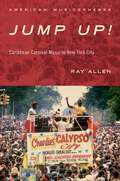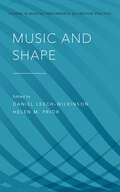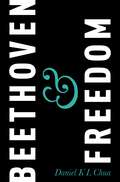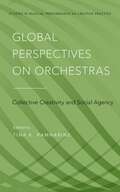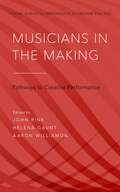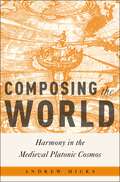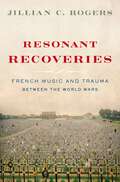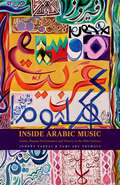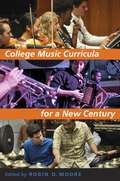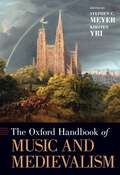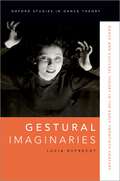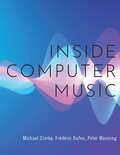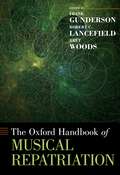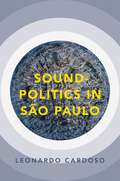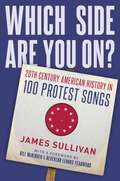- Table View
- List View
Jump Up!: Caribbean Carnival Music in New York (American Musicspheres)
by Ray AllenJump Up! Caribbean Carnival Music in New York City is the first comprehensive history of Trinidadian calypso and steelband music in the diaspora. Carnival, transplanted from Trinidad to Harlem in the 1930s and to Brooklyn in the late 1960s, provides the cultural context for the study. Blending oral history, archival research, and ethnography, Jump Up! examines how members of New York's diverse Anglophile-Caribbean communities forged transnational identities through the self-conscious embrace and transformation of select Carnival music styles and performances. The work fills a significant void in our understanding of how Caribbean Carnival music-specifically calypso, soca (soul/calypso), and steelband-evolved in the second half of the twentieth century as it flowed between its Island homeland and its bourgeoning New York migrant community. Jump Up! addresses the issues of music, migration, and identity head on, exploring the complex cycling of musical practices and the back-and-forth movement of singers, musicians, arrangers, producers, and cultural entrepreneurs between New York's diasporic communities and the Caribbean.
JUMP UP! AM C: Caribbean Carnival Music in New York (American Musicspheres)
by Ray AllenJump Up! Caribbean Carnival Music in New York City is the first comprehensive history of Trinidadian calypso and steelband music in the diaspora. Carnival, transplanted from Trinidad to Harlem in the 1930s and to Brooklyn in the late 1960s, provides the cultural context for the study. Blending oral history, archival research, and ethnography, Jump Up! examines how members of New York's diverse Anglophile-Caribbean communities forged transnational identities through the self-conscious embrace and transformation of select Carnival music styles and performances. The work fills a significant void in our understanding of how Caribbean Carnival music-specifically calypso, soca (soul/calypso), and steelband-evolved in the second half of the twentieth century as it flowed between its Island homeland and its bourgeoning New York migrant community. Jump Up! addresses the issues of music, migration, and identity head on, exploring the complex cycling of musical practices and the back-and-forth movement of singers, musicians, arrangers, producers, and cultural entrepreneurs between New York's diasporic communities and the Caribbean.
Music and Shape (Studies in Musical Perf as Creative Prac)
by Daniel Leech-Wilkinson and Helen M. PriorShape is a concept widely used in talk about music. Musicians in classical, popular, jazz and world musics use it to help them rehearse, teach and think about what they do. Yet why is a word that seems to require something to see or to touch so useful to describe something that sounds? Music and Shape examines numerous aspects of this surprisingly close relationship, with contributions from scholars and musicians, artists, dancers, filmmakers, and synaesthetes. The main chapters are provided by leading scholars from music psychology, music analysis, music therapy, dance, classical, jazz and popular music who examine how shape makes sense in music from their varied points of view. Here we see shape providing a key notion for the teaching and practice of performance nuance or prosody; as a way of making relationships between sound and body movement; as a link between improvisational as well as compositional design and listener response, and between notation, sound and cognition; and as a unimodal quality linked to vitality affects. Reflections from practitioners, between the chapters, offer complementary insights, embracing musical form, performance and composition styles, body movement, rhythm, harmony, timbre, narrative, emotions and feelings, and beginnings and endings. Music and Shape opens up new perspectives on musical performance, music psychology and music analysis, making explicit and open to investigation a vital factor in musical thinking and experience previously viewed merely as a metaphor.
Beethoven & Freedom
by Daniel K ChuaOver the last two centuries, Beethoven's music has been synonymous with the idea of freedom, in particular a freedom embodied in the heroic figure of Prometheus. This image arises from a relatively small circle of heroic works from the composer's middle period, most notably the Eroica Symphony. However, the freedom associated with the Promethean hero has also come under considerably critique by philosophers, theologians and political theorists; its promise of autonomy easily inverts into various forms of authoritarianism, and the sovereign will it champions is not merely a liberating force but a discriminatory one. Beethoven's freedom, then, appears to be increasingly problematic; yet his music is still employed today to mark political events from the fall of the Berlin Wall to the attacks of 9/11. Even more problematic, perhaps, is the fact that this freedom has shaped the reception of Beethoven music to such an extent that we forget that there is another kind of music in his oeuvre that is not heroic, a music that opens the possibility of a freedom yet to be articulated or defined. By exploring the musical philosophy of Theodor W. Adorno through a wide range of the composer's music, Beethoven and Freedom arrives at a markedly different vision of freedom. Author Daniel KL Chua suggests that a more human and fragile concept of freedom can be found in the music that has less to do with the autonomy of the will and its stoical corollary than with questions of human relation, donation, and a yielding to radical alterity. Chua's work makes a major and controversial statement by challenging the current image of Beethoven, and by suggesting an alterior freedom that can speak ethically to the twenty-first century.
Global Perspectives on Orchestras: Collective Creativity and Social Agency (Studies in Musical Perf as Creative Prac)
by Tina K. RamnarineOffering innovative approaches to thinking about orchestras, Global Perspectives on Orchestras: Collective Creativity and Social Agency adopts ethnographic, historical and comparative perspectives on a variety of traditions, including symphony, Caribbean steel, Indonesian gamelan, Indian film and Vietnamese court examples. The volume presents compelling analyses of orchestras in their socio-historical, economic, intercultural and postcolonial contexts, while emphasizing the global and historical connections between musical traditions. By drawing on new ethnographic and historical data, the essays describe orchestral creative processes and the politics shaping performance practices. Each essay considers how musicians work together in ensembles, focusing on issues such as training, rehearsal, creative choices, compositional processes, and organizational infrastructures. Testimonies of orchestral musicians highlight practitioners' views into the diverse world of orchestras. As a whole, the volume discusses the creative roles of performers, arrangers, composers and arts agencies, as well as the social environments supporting musical collaborations. With contributions from an international team of researchers, Global Perspectives on Orchestras offers critical insights gained from the study of orchestras, collective creativity and social agency, and the connections between orchestral performances, colonial histories, postcolonial practices, ethnographic writings and comparative theorizations.
Musicians in the Making: Pathways to Creative Performance (Studies in Musical Performance as Creative Practice)
by John Rink, Helena Gaunt and Aaron WilliamonMusicians are continually 'in the making', tapping into their own creative resources while deriving inspiration from teachers, friends, family members and listeners. Amateur and professional performers alike tend not to follow fixed routes in developing a creative voice: instead, their artistic journeys are personal, often without foreseeable goals. The imperative to assess and reassess one's musical knowledge, understanding and aspirations is nevertheless a central feature of life as a performer. Musicians in the Making explores the creative development of musicians in both formal and informal learning contexts. It promotes a novel view of creativity, emphasizing its location within creative processes rather than understanding it as an innate quality. It argues that such processes may be learned and refined, and furthermore that collaboration and interaction within group contexts carry significant potential to inform and catalyze creative experiences and outcomes. The book also traces and models the ways in which creative processes evolve over time. Performers, music teachers and researchers will find the rich body of material assembled here engaging and enlightening. The book's three parts focus in turn on 'Creative learning in context', 'Creative processes' and 'Creative dialogue and reflection'. In addition to sixteen extended chapters written by leading experts in the field, the volume includes ten 'Insights' by internationally prominent performers, performance teachers and others. Practical aids include abstracts and lists of keywords at the start of each chapter, which provide useful overviews and guidance on content. Topics addressed by individual authors include intrapersonal and interpersonal dynamics, performance experience, practice and rehearsal, 'self-regulated performing', improvisation, self-reflection, expression, interactions between performers and audiences, assessment, and the role of academic study in performers' development.
Composing the World: Harmony in the Medieval Platonic Cosmos (Critical Conjunctures in Music and Sound)
by Andrew Hicks"We can hear the universe!" This was the triumphant proclamation at a February 2016 press conference announcing that the Laser Interferometer Gravity Observatory (LIGO) had detected a "transient gravitational-wave signal." What LIGO heard in the morning hours of September 14, 2015 was the vibration of cosmic forces unleashed with mind-boggling power across a cosmic medium of equally mind-boggling expansiveness: the transient ripple of two black holes colliding more than a billion years ago. The confirmation of gravitational waves sent tremors through the scientific community, but the public imagination was more captivated by the sonic translation of the cosmic signal, a sound detectable only through an act of carefully attuned listening. As astrophysicist Szabolcs Marka remarked, "Until this moment, we had our eyes on the sky and we couldn't hear the music. The skies will never be the same." Taking in hand this current "discovery" that we can listen to the cosmos, Andrew Hicks argues that sound--and the harmonious coordination of sounds, sources, and listeners--has always been an integral part of the history of studying the cosmos. Composing the World charts one constellation of musical metaphors, analogies, and expressive modalities embedded within a late-ancient and medieval cosmological discourse: that of a cosmos animated and choreographed according to a specifically musical aesthetic. The specific historical terrain of Hicks' discussion centers upon the world of twelfth-century philosophy, and from there he offers a new intellectual history of the role of harmony in medieval cosmological discourse, a discourse which itself focused on the reception and development of Platonism. Hicks illuminates how a cosmological aesthetics based on the "music of the spheres" both governed the moral, physical, and psychic equilibrium of the human, and assured the coherence of the universe as a whole. With a rare convergence of musicological, philosophical, and philological rigor, Hicks presents a narrative tour through medieval cosmology with reflections on important philosophical movements along the way, raising connections to Cartesian dualism, Uexküll's theoretical biology, and Deleuze and Guattari's musically inspired language of milieus and (de)territorialization. Hicks ultimately suggests that the models of musical cosmology popular in late antiquity and the twelfth century are relevant to our modern philosophical and scientific undertakings. Impeccably researched and beautifully written, Composing the World will resonate with a variety of readers, and it encourages us to rethink the role of music and sound within our greater understanding of the universe.
Composing the World: Harmony in the Medieval Platonic Cosmos (Critical Conjunctures in Music and Sound)
by Andrew Hicks"We can hear the universe!" This was the triumphant proclamation at a February 2016 press conference announcing that the Laser Interferometer Gravity Observatory (LIGO) had detected a "transient gravitational-wave signal." What LIGO heard in the morning hours of September 14, 2015 was the vibration of cosmic forces unleashed with mind-boggling power across a cosmic medium of equally mind-boggling expansiveness: the transient ripple of two black holes colliding more than a billion years ago. The confirmation of gravitational waves sent tremors through the scientific community, but the public imagination was more captivated by the sonic translation of the cosmic signal, a sound detectable only through an act of carefully attuned listening. As astrophysicist Szabolcs Marka remarked, "Until this moment, we had our eyes on the sky and we couldn't hear the music. The skies will never be the same." Taking in hand this current "discovery" that we can listen to the cosmos, Andrew Hicks argues that sound--and the harmonious coordination of sounds, sources, and listeners--has always been an integral part of the history of studying the cosmos. Composing the World charts one constellation of musical metaphors, analogies, and expressive modalities embedded within a late-ancient and medieval cosmological discourse: that of a cosmos animated and choreographed according to a specifically musical aesthetic. The specific historical terrain of Hicks' discussion centers upon the world of twelfth-century philosophy, and from there he offers a new intellectual history of the role of harmony in medieval cosmological discourse, a discourse which itself focused on the reception and development of Platonism. Hicks illuminates how a cosmological aesthetics based on the "music of the spheres" both governed the moral, physical, and psychic equilibrium of the human, and assured the coherence of the universe as a whole. With a rare convergence of musicological, philosophical, and philological rigor, Hicks presents a narrative tour through medieval cosmology with reflections on important philosophical movements along the way, raising connections to Cartesian dualism, Uexküll's theoretical biology, and Deleuze and Guattari's musically inspired language of milieus and (de)territorialization. Hicks ultimately suggests that the models of musical cosmology popular in late antiquity and the twelfth century are relevant to our modern philosophical and scientific undertakings. Impeccably researched and beautifully written, Composing the World will resonate with a variety of readers, and it encourages us to rethink the role of music and sound within our greater understanding of the universe.
Resonant Recoveries: French Music and Trauma Between the World Wars
by Jillian C. RogersCoping with trauma and the losses of World War I was a central concern for French musicians in the interwar period. Almost all of them were deeply affected by the war as they fought in the trenches, worked in military hospitals, or mourned a friend or relative who had been wounded, killed, or taken prisoner. In Resonant Recoveries, author Jillian C. Rogers argues that French modernist composers processed this experience of unprecedented violence by turning their musical activities into locations for managing and performing trauma. Through analyses of archival materials, French medical, philosophical, and literary texts, and the music produced between the wars, Rogers frames World War I as a pivotal moment in the history of music therapy. When musicians and their audiences used music to remember lost loved ones, perform grief, create healing bonds of friendship, and find consolation in soothing sonic vibrations and rhythmic bodily movements, they reconfigured music into an embodied means of consolation--a healer of wounded minds and bodies. This in-depth account of the profound impact that postwar trauma had on French musical life makes a powerful case for the importance of addressing trauma, mourning, and people's emotional lives in music scholarship. This is an open access title available under the terms of a CC BY-NC-ND 4.0 licence. It is free to read at Oxford Scholarship Online and offered as a free PDF download from OUP and selected open access locations.
Resonant Recoveries: French Music and Trauma Between the World Wars
by Jillian C. RogersCoping with trauma and the losses of World War I was a central concern for French musicians in the interwar period. Almost all of them were deeply affected by the war as they fought in the trenches, worked in military hospitals, or mourned a friend or relative who had been wounded, killed, or taken prisoner. In Resonant Recoveries, author Jillian C. Rogers argues that French modernist composers processed this experience of unprecedented violence by turning their musical activities into locations for managing and performing trauma. Through analyses of archival materials, French medical, philosophical, and literary texts, and the music produced between the wars, Rogers frames World War I as a pivotal moment in the history of music therapy. When musicians and their audiences used music to remember lost loved ones, perform grief, create healing bonds of friendship, and find consolation in soothing sonic vibrations and rhythmic bodily movements, they reconfigured music into an embodied means of consolation--a healer of wounded minds and bodies. This in-depth account of the profound impact that postwar trauma had on French musical life makes a powerful case for the importance of addressing trauma, mourning, and people's emotional lives in music scholarship. This is an open access title available under the terms of a CC BY-NC-ND 4.0 licence. It is free to read at Oxford Scholarship Online and offered as a free PDF download from OUP and selected open access locations.
Inside Arabic Music: Arabic Maqam Performance and Theory in the 20th Century
by Johnny Farraj Sami Abu ShumaysWhat makes hundreds of listeners cheer ecstatically at the same instant during a live concert by Egyptian diva Umm Kulthum? What is the unspoken language behind a taqsim (traditional instrumental improvisation) that performers and listeners implicitly know? How can Arabic music be so rich and diverse without resorting to harmony? Why is it so challenging to transcribe Arabic music from a recording? Inside Arabic Music answers these and many other questions from the perspective of two "insiders" to the practice of Arabic music, by documenting a performance culture and a know-how that is largely passed on orally. Arabic music has spread across the globe, influencing music from Greece all the way to India in the mid-20th century through radio and musical cinema, and global popular culture through Raqs Sharqi, known as "Bellydance" in the West. Yet despite its popularity and influence, Arabic music, and the maqam scale system at its heart, remain widely misunderstood. Inside Arabic Music de-mystifies maqam with an approach that draws theory directly from practice, and presents theoretical insights that will be useful to practitioners, from the beginner to the expert - as well as those interested in the related Persian, Central Asian, and Turkish makam traditions. Inside Arabic Music's discussion of maqam and improvisation widens general understanding of music as well, by bringing in ideas from Saussurean linguistics, network theory, and Lakoff and Johnson's theory of cognition as metaphor, with an approach parallel to Gjerdingen's analysis of Galant-period music - offering a lens into the deeper relationships among music, culture, and human community.
INSIDE ARABIC MUSIC C: Arabic Maqam Performance and Theory in the 20th Century
by Johnny Farraj Sami Abu ShumaysWhat makes hundreds of listeners cheer ecstatically at the same instant during a live concert by Egyptian diva Umm Kulthum? What is the unspoken language behind a taqsim (traditional instrumental improvisation) that performers and listeners implicitly know? How can Arabic music be so rich and diverse without resorting to harmony? Why is it so challenging to transcribe Arabic music from a recording? Inside Arabic Music answers these and many other questions from the perspective of two "insiders" to the practice of Arabic music, by documenting a performance culture and a know-how that is largely passed on orally. Arabic music has spread across the globe, influencing music from Greece all the way to India in the mid-20th century through radio and musical cinema, and global popular culture through Raqs Sharqi, known as "Bellydance" in the West. Yet despite its popularity and influence, Arabic music, and the maqam scale system at its heart, remain widely misunderstood. Inside Arabic Music de-mystifies maqam with an approach that draws theory directly from practice, and presents theoretical insights that will be useful to practitioners, from the beginner to the expert - as well as those interested in the related Persian, Central Asian, and Turkish makam traditions. Inside Arabic Music's discussion of maqam and improvisation widens general understanding of music as well, by bringing in ideas from Saussurean linguistics, network theory, and Lakoff and Johnson's theory of cognition as metaphor, with an approach parallel to Gjerdingen's analysis of Galant-period music - offering a lens into the deeper relationships among music, culture, and human community.
College Music Curricula for a New Century
Critiques and calls for reform have existed for decades within music education, but few publications have offered concrete suggestions as to how things might be done differently. Motivated by a desire to do just that, College Music Curricula for a New Century considers what a more inclusive, dynamic, and socially engaged curriculum of musical study might look like in universities. Editor Robin Moore creates a dialogue among faculty, administrators, and students about what the future of college music instruction should be and how teachers, institutions, and organizations can transition to new paradigms. Including contributions from leading figures in ethnomusicology, music education, theory/composition, professional performance, and administration, College Music Curricula for a New Century addresses college-level curriculum reform, focusing primarily on performance and music education degrees, and offer ideas and examples for a more inclusive, dynamic, and socially engaged curriculum of applied musical study. This book will appeal to thoughtful faculty looking for direction on how to enact reform, to graduate students with investment in shaping future music curricula, and to administrators who know change is on the horizon and seek wisdom and practical advice for implementing change. College Music Curricula for a New Century reaches far beyond any musical subdiscipline and addresses issues pertinent to all areas of music study.
COLLEGE MUSIC CURRICULA FOR A NEW CENT C
by Robin D. MooreCritiques and calls for reform have existed for decades within music education, but few publications have offered concrete suggestions as to how things might be done differently. Motivated by a desire to do just that, College Music Curricula for a New Century considers what a more inclusive, dynamic, and socially engaged curriculum of musical study might look like in universities. Editor Robin Moore creates a dialogue among faculty, administrators, and students about what the future of college music instruction should be and how teachers, institutions, and organizations can transition to new paradigms. Including contributions from leading figures in ethnomusicology, music education, theory/composition, professional performance, and administration, College Music Curricula for a New Century addresses college-level curriculum reform, focusing primarily on performance and music education degrees, and offer ideas and examples for a more inclusive, dynamic, and socially engaged curriculum of applied musical study. This book will appeal to thoughtful faculty looking for direction on how to enact reform, to graduate students with investment in shaping future music curricula, and to administrators who know change is on the horizon and seek wisdom and practical advice for implementing change. College Music Curricula for a New Century reaches far beyond any musical subdiscipline and addresses issues pertinent to all areas of music study.
The Oxford Handbook of Music and Medievalism (Oxford Handbooks)
The Oxford Handbook of Music and Medievalism provides a snapshot of the diverse ways in which medievalism--the retrospective immersion in the images, sounds, narratives, and ideologies of the European Middle Ages--powerfully transforms many of the varied musical traditions of the last two centuries. Thirty-three chapters from an international group of scholars explore topics ranging from the representation of the Middle Ages in nineteenth-century opera to medievalism in contemporary video game music, thereby connecting disparate musical forms across typical musicological boundaries of chronology and geography. While some chapters focus on key medievalist works such as Orff's Carmina Burana or Peter Jackson's Lord of the Rings films, others explore medievalism in the oeuvre of a single composer (e.g. Richard Wagner or Arvo Pärt) or musical group (e.g. Led Zeppelin). The topics of the individual chapters include both well-known works such as John Boorman's film Excalibur and also less familiar examples such as Eduard Lalo's Le Roi d'Ys. The authors of the chapters approach their material from a wide array of disciplinary perspectives, including historical musicology, popular music studies, music theory, and film studies, examining the intersections of medievalism with nationalism, romanticism, ideology, nature, feminism, or spiritualism. Taken together, the contents of the Handbook develop new critical insights that venture outside traditional methodological constraints and provide a capstone and point of departure for future scholarship on music and medievalism.
The Oxford Handbook of Music and Medievalism (Oxford Handbooks)
by Stephen C. Meyer Kirsten YriThe Oxford Handbook of Music and Medievalism provides a snapshot of the diverse ways in which medievalism--the retrospective immersion in the images, sounds, narratives, and ideologies of the European Middle Ages--powerfully transforms many of the varied musical traditions of the last two centuries. Thirty-three chapters from an international group of scholars explore topics ranging from the representation of the Middle Ages in nineteenth-century opera to medievalism in contemporary video game music, thereby connecting disparate musical forms across typical musicological boundaries of chronology and geography. While some chapters focus on key medievalist works such as Orff's Carmina Burana or Peter Jackson's Lord of the Rings films, others explore medievalism in the oeuvre of a single composer (e.g. Richard Wagner or Arvo Pärt) or musical group (e.g. Led Zeppelin). The topics of the individual chapters include both well-known works such as John Boorman's film Excalibur and also less familiar examples such as Eduard Lalo's Le Roi d'Ys. The authors of the chapters approach their material from a wide array of disciplinary perspectives, including historical musicology, popular music studies, music theory, and film studies, examining the intersections of medievalism with nationalism, romanticism, ideology, nature, feminism, or spiritualism. Taken together, the contents of the Handbook develop new critical insights that venture outside traditional methodological constraints and provide a capstone and point of departure for future scholarship on music and medievalism.
Gestural Imaginaries: Dance and Cultural Theory in the Early Twentieth Century (Oxford Studies in Dance Theory)
by Lucia RuprechtGestural Imaginaries: Dance and Cultural Theory in the Early Twentieth Century offers a new interpretation of European modernist dance by addressing it as guiding medium in a vibrant field of gestural culture that ranged across art and philosophy. Taking further Cornelius Castoriadis's concept of the social imaginary, it explores this imaginary's embodied forms. Close readings of dances, photographs, and literary texts are juxtaposed with discussions of gestural theory by thinkers including Walter Benjamin, Sigmund Freud, and Aby Warburg. Choreographic gesture is defined as a force of intermittency that creates a new theoretical status of dance. Author Lucia Ruprecht shows how this also bears on contemporary theory. She shifts emphasis from Giorgio Agamben's preoccupation with gestural mediality to Jacques Ranci?re's multiplicity of proliferating, singular gestures, arguing for their ethical and political relevance. Mobilizing dance history and movement analysis, Ruprecht highlights the critical impact of works by choreographers such as Vaslav Nijinsky, Jo Mihaly, and Alexander and Clotilde Sakharoff. She also offers choreographic readings of Franz Kafka and Alfred D?blin. Gestural Imaginaries proposes that modernist dance conducts a gestural revolution which enacts but also exceeds the insights of past and present cultural theory. It makes a case for archive-based, cross-medial, and critically informed dance studies, transnational German studies, and the theoretical potential of performance itself.
Gestural Imaginaries: Dance and Cultural Theory in the Early Twentieth Century (Oxford Studies in Dance Theory)
by Lucia RuprechtGestural Imaginaries: Dance and Cultural Theory in the Early Twentieth Century offers a new interpretation of European modernist dance by addressing it as guiding medium in a vibrant field of gestural culture that ranged across art and philosophy. Taking further Cornelius Castoriadis's concept of the social imaginary, it explores this imaginary's embodied forms. Close readings of dances, photographs, and literary texts are juxtaposed with discussions of gestural theory by thinkers including Walter Benjamin, Sigmund Freud, and Aby Warburg. Choreographic gesture is defined as a force of intermittency that creates a new theoretical status of dance. Author Lucia Ruprecht shows how this also bears on contemporary theory. She shifts emphasis from Giorgio Agamben's preoccupation with gestural mediality to Jacques Ranci?re's multiplicity of proliferating, singular gestures, arguing for their ethical and political relevance. Mobilizing dance history and movement analysis, Ruprecht highlights the critical impact of works by choreographers such as Vaslav Nijinsky, Jo Mihaly, and Alexander and Clotilde Sakharoff. She also offers choreographic readings of Franz Kafka and Alfred D?blin. Gestural Imaginaries proposes that modernist dance conducts a gestural revolution which enacts but also exceeds the insights of past and present cultural theory. It makes a case for archive-based, cross-medial, and critically informed dance studies, transnational German studies, and the theoretical potential of performance itself.
Inside Computer Music
by Michael Clarke Frédéric Dufeu Peter ManningInside Computer Music is an investigation of how new technological developments have influenced the creative possibilities of composers of computer music in the last 50 years. This book combines detailed research into the development of computer music techniques with nine case studies that analyze key works in the musical and technical development of computer music. The book's companion website offers demonstration videos of the techniques used and downloadable software. There, readers can view interviews and test emulations of the software used by the composers for themselves. The software also presents musical analyses of each of the nine case studies to enable readers to engage with the musical structure aurally and interactively.
INSIDE COMPUTER MUSIC C
by Michael Clarke Peter Manning Frédéric DufeuInside Computer Music is an investigation of how new technological developments have influenced the creative possibilities of composers of computer music in the last 50 years. This book combines detailed research into the development of computer music techniques with nine case studies that analyze key works in the musical and technical development of computer music. The book's companion website offers demonstration videos of the techniques used and downloadable software. There, readers can view interviews and test emulations of the software used by the composers for themselves. The software also presents musical analyses of each of the nine case studies to enable readers to engage with the musical structure aurally and interactively.
The Oxford Handbook of Musical Repatriation (Oxford Handbooks)
The Oxford Handbook of Musical Repatriation is a significant edited volume that critically explores issues surrounding musical repatriation, chiefly of recordings from audiovisual archives. The Handbook provides a dynamic and richly layered collection of stories and critical questions for anyone engaged or interested in repatriation or archival work. Repatriation often is overtly guided by an ethical mandate to "return" something to where it belongs, by such means as working to provide reconnection and Indigenous control and access to cultural materials. Essential as these mandates can be, this remarkable volume reveals dimensions to repatriation beyond those which can be understood as simple acts of "giving back" or returning an archive to its "homeland." Musical repatriation can entail subjective negotiations involving living subjects, intangible elements of cultural heritage, and complex histories, situated in intersecting webs of power relations and manifold other contexts. The forty-eight expert authors of this book's thirty-eight chapters engage with multifaceted aspects of musical repatriation, situating it as a concept encompassing widely ranging modes of cultural work that can be both profoundly interdisciplinary and embedded at the core of ethnographic and historical scholarship. These authors explore a rich variety of these processes' many streams, making the volume a compelling space for critical analysis of musical repatriation and its wider significance. The Handbook presents these chapters in a way that offers numerous emergent perspectives, depending on one's chosen trajectory through the volume. From retracing the paths of archived collections to exploring memory, performance, research goals, institutional power, curation, preservation, pedagogy and method, media and transmission, digital rights and access, policy and privilege, intellectual property, ideology, and the evolving institutional norms that have marked the preservation and ownership of musical archives-The Oxford Handbook of Musical Repatriation addresses these key topics and more in a deep, richly detailed, and diverse exploration.
Sound-Politics in São Paulo (Currents in Latin American and Iberian Music)
by Leonardo CardosoHow does the state separate music from noise? How can such a filtering apparatus shape the content and form of sound production in the city? As a marker of co-presence to the hearing body, sound is always open to (or rather opens up) the politics of shared existence. In the throes of the post-dictatorship period, Brazil's legislative and executive branches implemented a series of sweeping measures to address quality of life concerns, including environmental pollution and urban inequality. In São Paulo, noise control became a recurrent controversy, growing in size and scale between the 1990s and 2010s. Together with the much-debated fear of crime and the socioeconomic and cultural tensions between the rich urban center and the poor peripheries, such ecological agendas against noise as a harmful pollutant have reconfigured the presence of environmental sounds in the city. In this book, Cardoso argues that the framing of specific sounds as unavoidable, unnecessary, or as harmful "noise" has been an effective strategy to organize spaces and administer group behavior in this rapidly expanding city. He focuses on two interrelated processes. First, the series of institutional regulatory mechanisms that turn sounds into the all-embracing "noise" susceptible to state intervention. Second, the constant attempts of interested groups in either attaching or detaching specific sounds (musical events, industrial noise, traffic noise, religious sounds, etc.) from regulatory scrutiny. Sound-politics is the dynamic that emerges from both processes - the channels through which sounds enter (and leave) the sphere of state regulation.
SOUND-POLITICS IN SAO PAULO CILAM C (Currents in Latin American and Iberian Music)
by Leonardo CardosoHow does the state separate music from noise? How can such a filtering apparatus shape the content and form of sound production in the city? As a marker of co-presence to the hearing body, sound is always open to (or rather opens up) the politics of shared existence. In the throes of the post-dictatorship period, Brazil's legislative and executive branches implemented a series of sweeping measures to address quality of life concerns, including environmental pollution and urban inequality. In São Paulo, noise control became a recurrent controversy, growing in size and scale between the 1990s and 2010s. Together with the much-debated fear of crime and the socioeconomic and cultural tensions between the rich urban center and the poor peripheries, such ecological agendas against noise as a harmful pollutant have reconfigured the presence of environmental sounds in the city. In this book, Cardoso argues that the framing of specific sounds as unavoidable, unnecessary, or as harmful "noise" has been an effective strategy to organize spaces and administer group behavior in this rapidly expanding city. He focuses on two interrelated processes. First, the series of institutional regulatory mechanisms that turn sounds into the all-embracing "noise" susceptible to state intervention. Second, the constant attempts of interested groups in either attaching or detaching specific sounds (musical events, industrial noise, traffic noise, religious sounds, etc.) from regulatory scrutiny. Sound-politics is the dynamic that emerges from both processes - the channels through which sounds enter (and leave) the sphere of state regulation.
Which Side Are You On?: 20th Century American History in 100 Protest Songs
by James SullivanWhen he emerged from the nightclubs of Greenwich Village, Bob Dylan was often identified as a "protest" singer. As early as 1962, however, Dylan was already protesting the label: "I don't write no protest songs," he told his audience on the night he debuted "Blowin' in the Wind." "Protest" music is largely perceived as an unsubtle art form, a topical brand of songwriting that preaches to the converted. But popular music of all types has long given listeners food for thought. Fifty years before Vietnam, before the United States entered World War I, some of the most popular sheet music in the country featured anti-war tunes. The labor movement of the early decades of the century was fueled by its communal "songbook." The Civil Rights movement was soundtracked not just by the gorgeous melodies of "Strange Fruit" and "A Change Is Gonna Come," but hundreds of other gospel-tinged ballads and blues. In Which Side Are You On, author James Sullivan delivers a lively anecdotal history of the progressive movements that have shaped the growth of the United States, and the songs that have accompanied and defined them. Covering one hundred years of social conflict and progress across the twentieth century and into the early years of the twenty-first, this book reveals how protest songs have given voice to the needs and challenges of a nation and asked its citizens to take a stand--asking the question "Which side are you on?"
Which Side Are You On?: 20th Century American History in 100 Protest Songs
by James SullivanWhen he emerged from the nightclubs of Greenwich Village, Bob Dylan was often identified as a "protest" singer. As early as 1962, however, Dylan was already protesting the label: "I don't write no protest songs," he told his audience on the night he debuted "Blowin' in the Wind." "Protest" music is largely perceived as an unsubtle art form, a topical brand of songwriting that preaches to the converted. But popular music of all types has long given listeners food for thought. Fifty years before Vietnam, before the United States entered World War I, some of the most popular sheet music in the country featured anti-war tunes. The labor movement of the early decades of the century was fueled by its communal "songbook." The Civil Rights movement was soundtracked not just by the gorgeous melodies of "Strange Fruit" and "A Change Is Gonna Come," but hundreds of other gospel-tinged ballads and blues. In Which Side Are You On, author James Sullivan delivers a lively anecdotal history of the progressive movements that have shaped the growth of the United States, and the songs that have accompanied and defined them. Covering one hundred years of social conflict and progress across the twentieth century and into the early years of the twenty-first, this book reveals how protest songs have given voice to the needs and challenges of a nation and asked its citizens to take a stand--asking the question "Which side are you on?"
